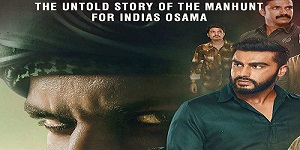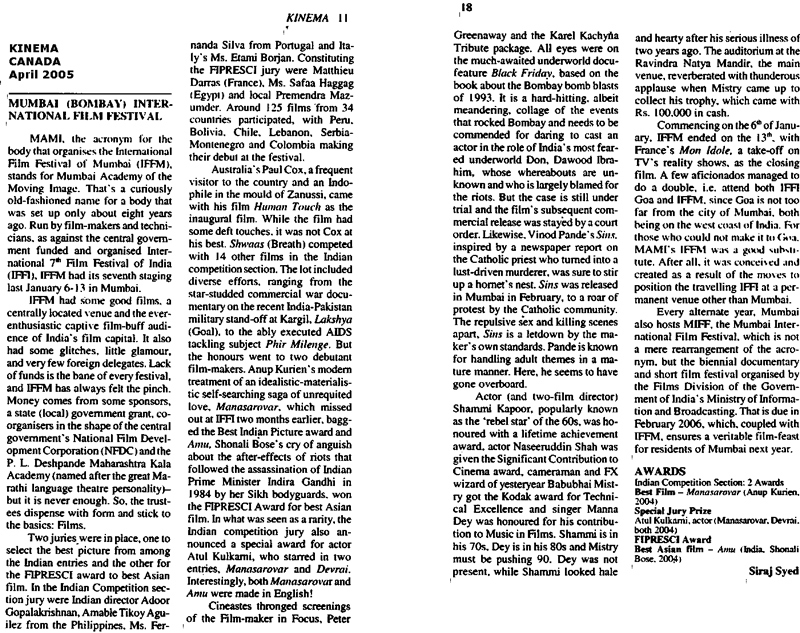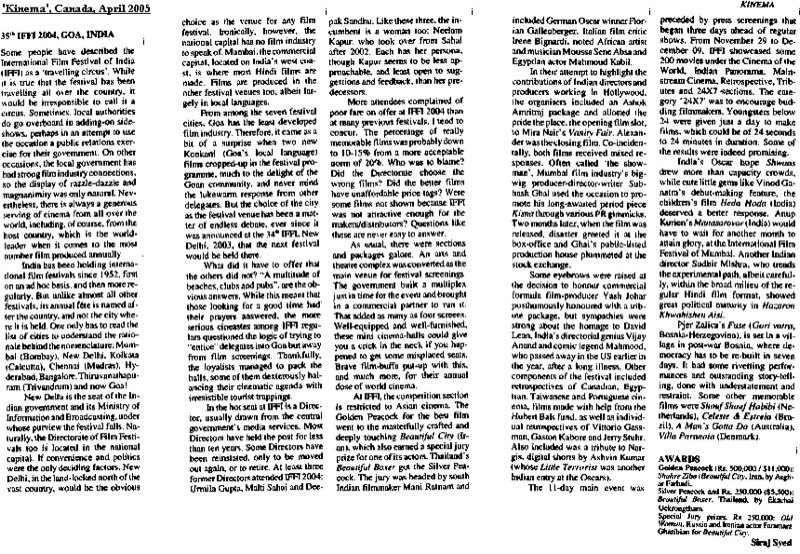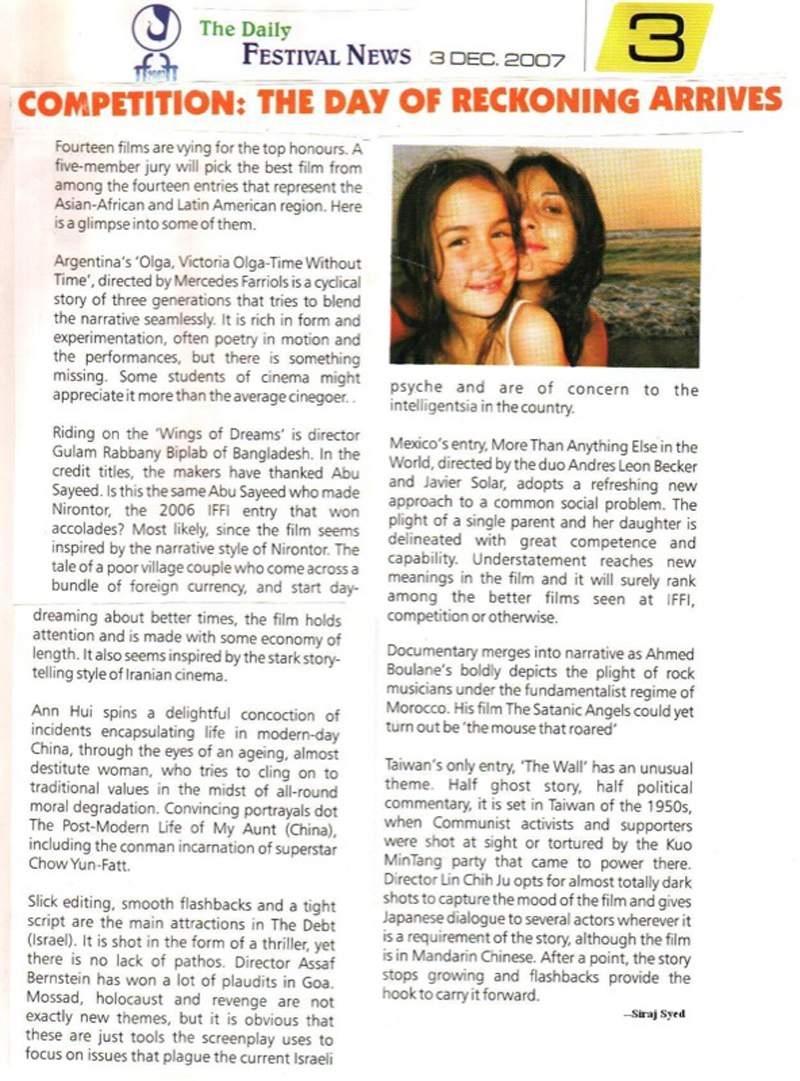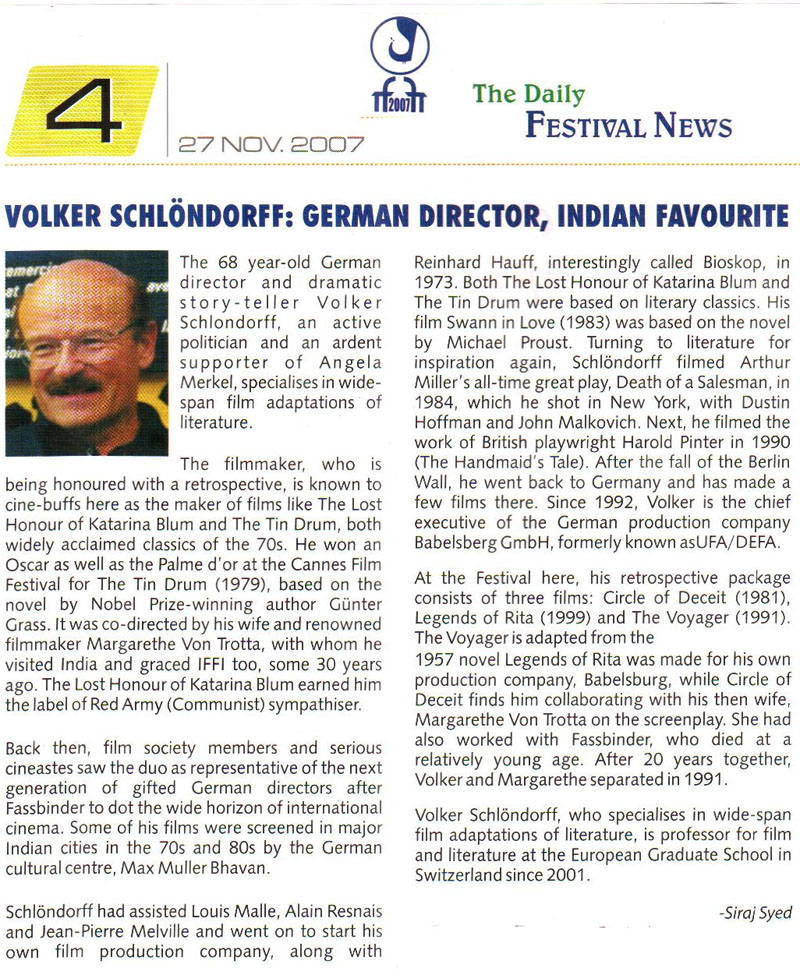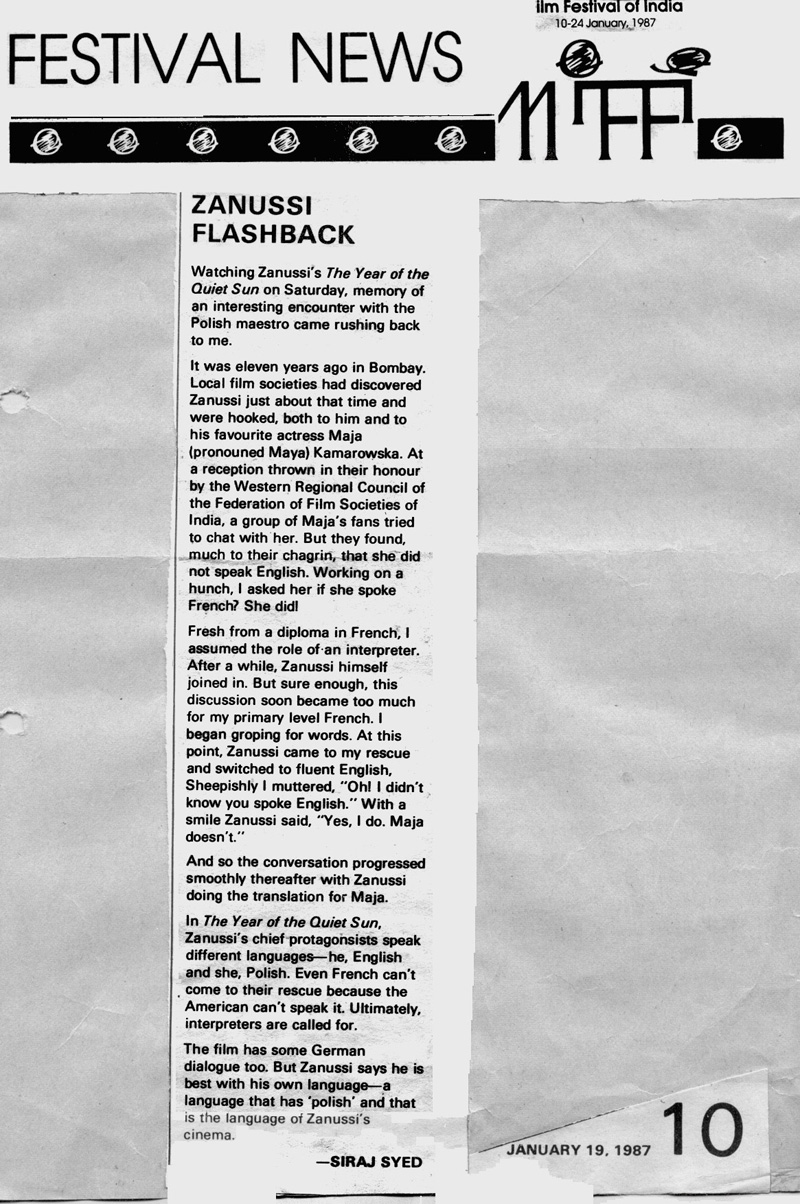|
|
||
|
Pro Tools
FILMFESTIVALS | 24/7 world wide coverageWelcome ! Enjoy the best of both worlds: Film & Festival News, exploring the best of the film festivals community. Launched in 1995, relentlessly connecting films to festivals, documenting and promoting festivals worldwide. We are currently working actively to upgrade this platform, sorry for the inconvenience. For collaboration, editorial contributions, or publicity, please send us an email here. User login |
Siraj SyedSiraj Syed is the India Correspondent for FilmFestivals.com and a member of FIPRESCI, the International Federation of Film Critics. He is a Film Festival Correspondent since 1976, Film-critic since 1969 and a Feature-writer since 1970. He is also an acting and dialogue coach. @SirajHSyed  India’s Most Wanted, Review: Mission without ammunition, found wanting
India’s Most Wanted, Review: Mission without ammunition, found wanting Indian spy thrillers have been on the scene ever since the first film of James from Thames was released in India in the early 1960s. They were broadly divided into categories: rip-offs of 007 and C grade thrillers, with action and a bit of titillation. Remarkably, some of them even managed to incorporate catchy songs into the narrative. In the last two decades, after international terrorism, other than the eternal border skirmishes with Pakistan and China, erupted in this part of the world, there has emerged a third category of international espionage film, the ‘based on a real story’ phylum realistica, like India’s Most Wanted. While there is empirical evidence to suggest that the basis of the film’s story is real, begins with so many disclaimers that the veracity of the script becomes questionable. India has seen dozens of bomb blasts, some of them serial in nature, across the country, attributed either to Pakistani operatives or Indian affiliates of the ISIS or Indian organisations with militant motives. After committing these heinous crimes, the perpetrators go back to Pakistan or seek sanctuary in countries like Nepal and Portugal. Nepal being geographically closest to India, and having an open border policy for Indian citizens, it is an ideal choice for the terrorist. India’s Most Wanted focusses on one particular blast, the one that took place in a Pune eatery, and the covert operation launched a group of dedicated Indian intelligence and field operatives to trace and capture the man responsible for the same. Along the way, the narrative is punctuated with a dozen odd blasts, which are mere insertions for shock and gore effect, and have no direct bearing on the running plot, though they do emphasise the need to nab the suspect, ASAP. Most of the film is shot in Nepal, with Rawalpindi (Pakistan) recreated for a few scenes, and the obligatory Indian segment, with bomb blasts, and as the HQ for the counter-terrorism operation and government agencies. In January 2018, Abdul Subhan Qureshi, accused of a string of bomb blasts that killed hundreds of innocent Indians, in places like Karnataka, Gujarat and Mumbai, between 2006 and 2018, was captured after a shoot-out with police in Delhi. He had been India’s most wanted man for over a decade, topping even the other King Mafioso, Dawood Ibrahim, and was sometimes referred to as “India’s Bin Laden”. The police recovered pistols and documents from Qureshi to indicate that he was trying to revive the Students Islamic Movement of India (SIMI) and the Indian Mujahideen (IM; mujahideen means strugglers), two organisations that were black-listed by the Indian Government. Abdul Subhan used many aliases. In the film, he is named Yusuf. Also, in the end credits, the film co-credits Bihar police with the honours, and actors in the crack team speak with a Bihari accent. Qureshi took refuge in Nepal in 2010, with the help of Haseeb Raza, who is named Javed ‘Machhlee’ in the film, but fled when he got information that Indian investigators were on his trail. He returned to Nepal in 2017, where he worked as an English teacher. The film has him practicing as a ‘hakeem’, s doctor of traditional Indo-Arab medicine, and shows him being apprehended in Pokhara, Nepal, without a shot being fired, by a team of Indian operatives who fund this unapproved operation with their own savings and risk their lives, since they have no back-up in Nepal. Taking liberties with story-lines is de rigueur with bio-pics and all films based on reality. In other words, reality is either incomplete, or bland, and would look like a boring documentary, which is what some of the Hollywood and British films of the 60s did. But then came an agent with a license to kill, and spy dramas suddenly became licentious. Simultaneously, we saw the maturing of minimal action-high tension spy dramas, based on the novels of John Le Carré, Roberet Ludlum, Frederick Forsyth, Tom Clancy and Ken Follet, among others. Le Carré (David John Moore Cornwell; now 87; former British Secret Service official) wrote his first novel in 1961, the year Ian Fleming’s Dr. No. started filming, and his last one was in 2017. Clancy was a newbie, who arrived in 1990 and passed away in 2013, aged 66. Since India’s Most Wanted is written and directed by Raj Kumar Gupta (Aamir, No One Killed Jessica, Raid: directed only) and he is one of the three producers, it qualifies as an auteur film. Aamir was adapted from the Filipino film Cavite, No One Killed Jessica was based on a true story and Raid was loosely inspired by a real case. All three films were crime thrillers of slightly varying hues and were largely appreciated. Ghanchakkar (2013, a flop), which he also wrote and directed, was dealt with in a black comedy vein, but with, nevertheless, crime at its core. It was adapted from various British and American bank heist movies. These five films in eleven years constituting his entire oeuvre, the director in Gupta apparently needs a substantive script to make it work and reality/remake seem to be his two middle names. Mise en scène is not his forté. An opening scene is so blatantly laden with Osama that you expect him to suddenly surface from his underground hideout. Strangely, however, the director does not connect it with the rest of the story. Or, going soft on him, the Central Board of Film Certification decapitated the scene. That is the only time we hear and see bullets being fired. For the rest, there is a mélange of the real Qureshi case, A Bridge of Spies (mainly the ‘mission without ammunition’) concept and some of Le Carré’s delineations. Patriotic chest-thumping is subdued, yet it is in sharp focus at least ten times in the film. “We will sacrifice everything for the country,” is a refrain you hear often. Notwithstanding national fervor, there is nothing new or inspiring about the dialogue, except the play upon the word “paagal” (mad), construed here as “mad about the motherland”. Full marks to Gupta for creating and developing the character of Friend, shared with the actor playing the role. Some more marks for having no major female characters in the film, never mind the fact that there is no action. Well, you could say that the Nepali woman, who seems to be an underworld Donna, is an exception, as is the Nepali girl who sings two songs in a club/bar. An SMS romance, initiated by a disembodied, never-shown, never-heard girl is all the hero gets, and the wife of a secret service chief is seen, but not heard. Decades ago, the taking of a conversation shot with the two actors walking briskly in corridors and a trolley following, used to have some novelty. Now, it looks silly. They can sit, stand, talk on the phone, have video calls, and so much more. Why walk the talk? Both such scenes, though there is nothing wrong in their taking in terms of film grammar, stick out as lazy writing. Gupta takes a top level conference to ridiculous levels, by having the convener asking his assistants to play a bhajan (Hindu song of praise to the Gods), since the various departments of police and intelligence who are attending the meeting have not been able to apprehend the terrorists who carried out attacks on Indian soil, and then apparently disappeared from the face of the earth. You cannot fault Raj Kumar Gupta for casting the bulky, brawny, intense-eyed Arjun Kapoor (Ishaqzaade, Gunday, 2 States; son of producer Boney Kapoor) as Prabhat, in a role that demanded an iron will and a poker face. Why he did not give him even one real action scene defies logic, though there is no rule that says that all well-built, macho men must have fight scenes. It is to the credit of actors of the calibre of Rajendra Gupta (a veteran) and Rajesh Sharma (quick rise to fame) that they do not let type-casting and stock situations peter down into farce. Shantilal Mukherjee, as Shaumiq Biswas, has to walk for 50% of his role, present an unconvinced look for 25% of his brief role and a slightly convinced look for the remaining 25%, which he does easily. Also in the cast are Devendra Mishra as Javed, Gaurav Mishra as Amit, Aasif Khan as Bittu, Bajrangbali Singh as Ravi, Pravin Singh Sisodia as Manish, Rajiv Kachroo as Dev and Alexander Prasanth as Pillai, the South Indian who recognises Yusuf’s voice as having a Kannadiga accent, thereby reconfirming his identity. Playing the arch villain, Sudev Nair, is given lofty quotes, which have become tedious after ten films that used similar lines to justify the villain’s villainy, as voice overs in over his shoulder or full-back to camera shots. He does not speak a word otherwise. Let’s say his portrayal meets our silent approval. And pray, where and who was Amrita Puri (Aisha, Blood Money, Kai Po Che)? Billed in the cast and conspicuous by her absence, she is the film’s most wanted actor. Now for the performance of the film, or of many films: Jitendra Shastri (Ashoka the Great, Lajja, Black Friday) as Friend, the shop-keeper in Nepal, who rats on Yusuf and is mainly responsible for the success of the operation, which had very little to justify itself. At 62, he might have arrived late, although he has been working since 1994. A faint Madhya Pradeshi accent is discernible, and that is not incongruous, since his character has not been given any roots. Gesture, posture, diction and mannerisms…take a bow, Jitendra. Composer Amit Trivedi and lyricist Amitabh Bhattacharya come together with Gupta for a fourth time, with disappointing results. The songs are weird and gibberish, apparently designed as such. Background music is at variance with the film in the first half and then races thumpingly ahead in the latter part. Editor Bodhatiya Banerjee takes his time establishing components and an eternity to reach the intermission (the film is 123 minutes long, with the Indian version having an intermission half-way) and the end. Blasts, naturally so, erupt suddenly, but each has a little prelude that makes it predictable. Then again, as auteur, it is Raj Kumar Gupta who is complicit and should own up to these shenanigans. Dudley’s cinematography is pleasing, with some top angle rain shots standing out. The tagline, “Five unlikely heroes will save a billion,” on the film’s Wikipedia page, is hyperbole raised to the power of ridicule. And this is no comedy. If you are an Arjun Kapoor fan and/or you want to discover a little-known actor who makes a big impression, watch it. Otherwise, we’ve been there, done that. So, if you want to take us there and make us do that again, you gotta make it very, very exciting. Five men, four days, tourist visas and no ammunition is not a big enough peg to hang India’s Most Wanted on. Clearly, this FOXSTAR movie is found wanting. Rating: ** Trailer: https://www.youtube.com/watch?v=xmab5E_62og 24.05.2019 | Siraj Syed's blog Cat. : Aasif Khan Abdul Subhan Qureshi Alexander Prasanth Amitabh Bhattacharya Amrita Puri Arjun Kapoor Bajrangbali Singh Bodhatiya Banerjee Boney Kapoor Devendra Mishra Dudley Frederick Forsyth Gaurav Mishra Haseeb Raza Ian Fleming John le Carre Ken Follet Nepal Pravin Singh Sisodia Raj Kumar Gupta Rajendra Gupta Rajesh Sharma Rajiv Kachroo Robert Ludlum Shantilal Mukherjee Sudev Nair Tom Clancy Trivedi Hollywood FILM
|
LinksThe Bulletin Board > The Bulletin Board Blog Following News Interview with EFM (Berlin) Director
Interview with IFTA Chairman (AFM)
Interview with Cannes Marche du Film Director
Filmfestivals.com dailies live coverage from > Live from India
Useful links for the indies: > Big files transfer
+ SUBSCRIBE to the weekly Newsletter DealsUser imagesAbout Siraj Syed Syed Siraj Syed Siraj (Siraj Associates) Siraj Syed is a film-critic since 1970 and a Former President of the Freelance Film Journalists' Combine of India.He is the India Correspondent of FilmFestivals.com and a member of FIPRESCI, the international Federation of Film Critics, Munich, GermanySiraj Syed has contributed over 1,015 articles on cinema, international film festivals, conventions, exhibitions, etc., most recently, at IFFI (Goa), MIFF (Mumbai), MFF/MAMI (Mumbai) and CommunicAsia (Singapore). He often edits film festival daily bulletins.He is also an actor and a dubbing artiste. Further, he has been teaching media, acting and dubbing at over 30 institutes in India and Singapore, since 1984.View my profile Send me a message The EditorUser contributions |

















